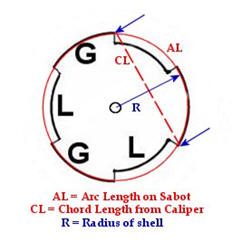
The smart phone application called ArcCalc can be used to identify rifled artillery from measurements of the impressed rifling found on projectile fragments. Rifled artillery from both sides possessed sabots that took the rifling of the rifle barrel. Typically, the sabots were made of a soft metal (lead, brass or copper). Wrought iron and, even wood, hemp and papier-mâché were also used.
Android and Apple ArcCalc apps are available from Play Store (for Android) and the Aps Store (for IOS). Both applications are called ArcCalc and are identical, even though the authors are different.
ArcCalc was first introduced in my webpage article: “Quick Way to Estimating the Diameter of Spherical and Elongate Projectile Fragments”.
Using ArcCalc, the arc length (AL in the figure below below) can be determined for a single pair of impressed rifling lands and grooves (L and G)) found along the sabot of the projectile.
The arc length is found from the measured chord length (CL) and the radius of the projectile. Using these results the total number of lands and groove rifling sets that can be fit abound the sabot can be estimated. This can then be used to identify the firing rifle.
The arc length of a single set of rifling lands and grooves will always be larger than the chord length and is a better estimate of the number of total land and groove sets around the circumference of the sabot.
The total number of land and groove sets can be used to identify the firing rifle.

Sabot of typical 3 lands and groves rifling on the end of a rifled projectile. Using ArcCalc, the Arc Length (AL) of a single pair of rifling lands and grooves found on the projectile’s sabot can be found from its measured Chord length (CL) and the radius of the projectile. Using these results the total number of lands and groove rifling sets can be estimated. This can then be used to identify the firing rifle.
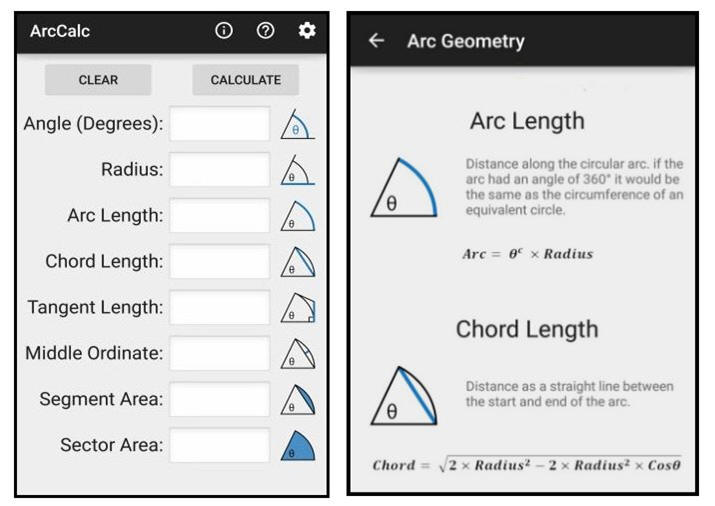
Finding the total number of Land and Groove sets:
C = Circumference of the sabot of the projectile and ϖ = 3.14159
D = Diameter or caliber of the projectile
N = the total number of Land and Groove sets around the circumference
(L+G) = the arc length of a single Land + Groove set
Note: The value of L+G is found from ArcCalc with the cord length measured by caliper of L+G.
C = ϖD = N(L+G)
Solving for N (total number of L+G sets around sabot)
N = ϖD/(L+G)
The value of N then can be used to identify the firing cannon.
An Interesting Example
Two Confederate Read pattern shell bases were found on the Federal side of an 1864 battlefield in Virginia. One of the bases showed some damage to its sabot on hitting the ground but still showed a single land and groove set from the rifling of its firing cannon.
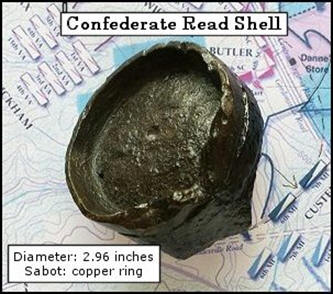
Typical Confederate Read pattern projectile from a Virginia battlefield. Note the lathe dimple found in the center of the projectile base.
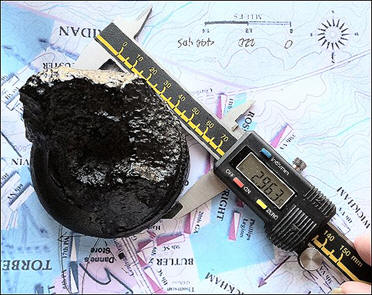
Read Projectile direct caliper diameter measure of 2.96 inches at bourrelet. Projectile radius (used in ArcCalc) =2.96/2=1.48 inches
The chord length of a single let of rifling lands and grooves set was measured with a caliper and found to be 1.27 inches. The cord length and radius of the projectile (half of its diameter) were input into the ArcCalc application and the arc length of the set was calculated to be 1.313 inches.
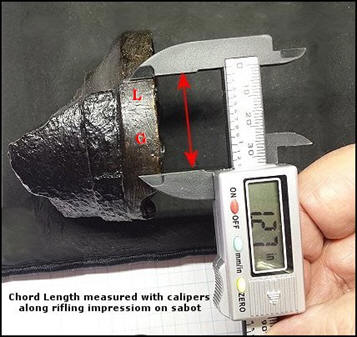
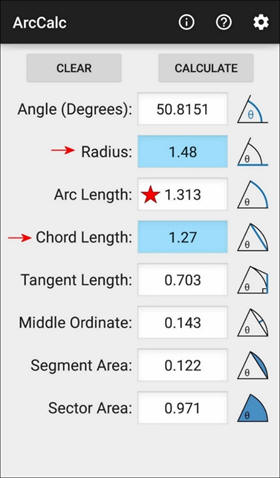
The L+G chord length value (1.27) and the measured radius (2.96/2) can be used in the above equations to obtain the estimated total number of land and groove sets (N) that could be fit abound the circumference of the sabot using the calculated L+G arc length (1.313):
N = ϖD/(L+G)
N = (3.14159(2.96))/1.313 = 7.08 sets
Interestingly:
The Confederate 3-inch Rifle had possible rifling patterns of 5, 6, or 12
lands and grooves sets.
The Federal 3-inch Ordnance Rifle had a single rifling of 7 lands and
grooves.
The Confederate Read projectile was fired from a captured Federal 3-inch Ordnance Rifle.
Using the chord length solution will always give a better estimate of the total number of sets than using the arc length.
Artillery projectile expert Peter George has suggested that the typical “windage” of a projectile in a rifle bore is 0.1 to 0.04 inches less than the bore itself. This allows the projectile to move freely in the bore.
Thus, from the example above the rifle bore was 3 inches, the estimated projectile diameter (“windage diameter”) would be in the range 2.90 to 2.96 inches. These would yield an ArcCalc arc length range of 1.302 to 1.328 inches.
In our example the calculated arc length was 1.313 lies within this range. If one compares the arc length ranges from the chart below over all rifles in the 2.9 to 3.3-inch bore range, the only rifle that fits is the 3-inch Federal Ordnance Rifle.
The Method
Use the direct caliber method (as above) or one of the methods from the website article (“Quick Way to Estimating the Diameter of Spherical and Elongate Projectile Fragments”.) to determine the diameter of the projectile fragment.
Input the radius (measured diameter value/2) and the estimate of the chord length of a single land and groove set on the projectile fragment into the ArcCalc application. This should produce the arc length of the land and groove set.
Compare this value to the arc length ranges ("windage diameter range") in the chart below for all bore values near the measured projectile diameter. The firing rifle identification and the total number of land and groove sets (N) are found on the same row of the chart.
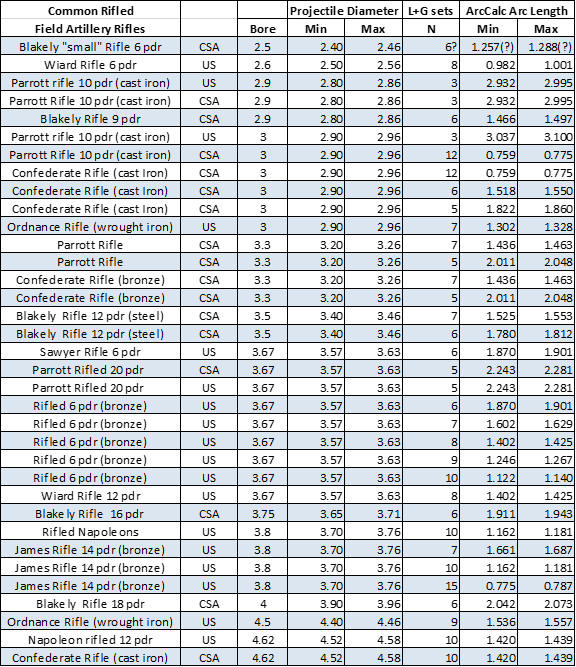
Author Note: The above article is based upon discussions with Civil War artillery expert Peter George. I am deeply indebted to him for these discussions and the sharing of his knowledge.
Good Additional Readings:
Dean S. Thomas, “Cannons: An Introduction to Civil War Artillery”; 1985; (ISBN 9780939631032); 72 pp.
Dickey, Thomas S. & George, Peter C., “Field Artillery Projectiles of the American Civil War”; 1993; Arsenal Publications; (ISBN 0960902201); 552 pp.
Jack W. Melton & Lawrence E. Pawl, “Guide to Civil War Artillery Projectiles”; 1996;Kennesaw Mountain Press; (ISBN 0-9635861-1-4); 96 pp.
John C. Hazlett, Edwin Olmstead, & M. Hume Parks, “Field Artillery Weapons of the Civil War”; Revised Edition; 1988; University of Chicago Press; (ISBN 0-252-07210-3); 322 pp.
Steven Roberts, “Captain Alexander Blakely RA”; 2012, www.scribd.com/document/97550420, 72 pp.
Download a PDF of this article.